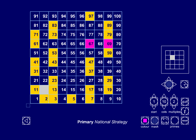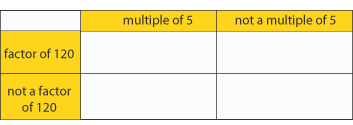Teaching guidance
This teaching guidance document suggests some of the key vocabulary, models, images and practical equipment that children should experience and be able to use. It also includes some teaching tips to provide a few starting points for ways of supporting children with this area of mathematics.
 Teaching guidance: Can I use knowledge of factors and multiples? | 73KB
Teaching guidance: Can I use knowledge of factors and multiples? | 73KB 
Consolidation and practice
These resources are to support children in guided or independent work. Roll over the highlighted resource for a description.
Number grid

This interactive teaching program (ITP) is an ICT-based tool to support the exploration of number, reasoning and problem solving. Number grid ITP allows the child or teacher to generate a number grid with different starting numbers, orientations and numbers of columns. Individual numbers or chosen multiples can be coloured and numbers masked to explore number sequences and patterns and develop children's ability to predict and generalise.
Opportunities to use and apply
Possible contexts include:
- Word problems, e.g. In a shape sequence, every third shape is a triangle and every fifth shape is red. Where in the sequence will the fourth red triangle lie?
- Number properties, e.g. Find the prime numbers to 100 using the Sieve of Eratosthenes.
- Fractions, e.g. write 24/32 in its simplest form. How did you use highest common factors to do this?
Confirming learning
Ask probing questions such as:
- Find a number between 230 and 240 that is a multiple of 9.
- List all the factors of 36. How many does it have? Most numbers have an even number of factors. Why is 36 a special case?
- Which is larger, 7/8 or 5/6? Explain how you worked this out. Could you have used a smaller denominator?
- Jake and Darren did a sponsored run. Jake earned £5 for every complete mile he ran. Darren earned £6 for every complete mile. They each raised the same amount of money, which was over £40 but under £80. How much money did each boy raise? How many miles did each boy run?
- It is possible to make the number 42 by multiplying together three prime numbers. Find them.
- Consider the numbers 20 and 12. What is their lowest common multiple? What is their highest common factor?
 ×
×  ×
×  = 231
= 231 Knowing and using number facts
Knowing and using number facts

